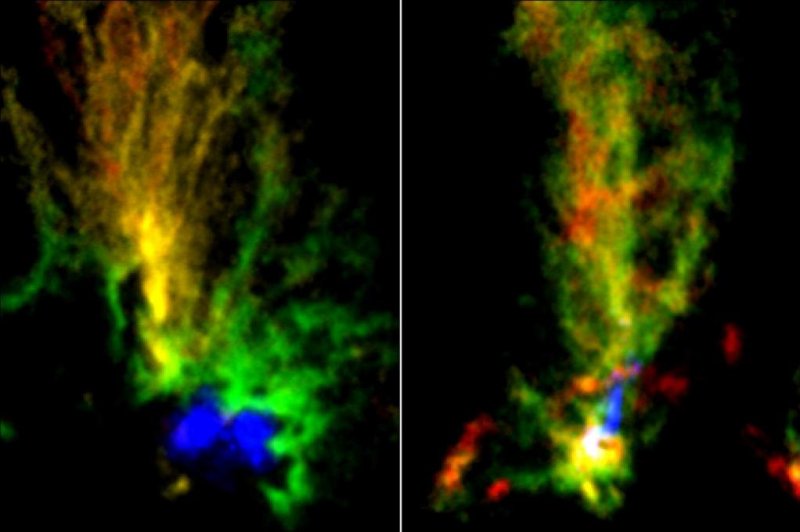Close analysis of a pair of filament in two distant molecular gas clouds suggests the pair's ancient collision fueled the birth of several massive protostars. Photo by ALMA (ESO/NAOJ/NRAO)/Fukui et al./Tokuda et al./NASA-ESA Hubble Space Telescope
Nov. 14 (UPI) -- Astronomers have found evidence that the violent history between a pair of peacock-shaped magellanic clouds best explains their similarly sized populations of of massive, young stars.
Though now far away from one another, the Large Magellanic Cloud and Small Magellanic Cloud collided some 200 million years ago. According to a new study, published Thursday in the Astrophysical Journal, the signature of their ancient tango is still evident.
For some time, scientists have been trying to figure out how massive stars form. Stars form from collapsing clouds, but giant stars, 10 times or more massive than our sun, require densities of gas and dust rarely seen in the universe.
Galactic collisions and violent interactions between magellanic clouds is one way gas and dust could be condensed into a small space, and the latest observations by the Atacama Large Millimeter/submillimeter Array, or ALMA, suggest that's what happened when Large Magellanic Cloud and Small Magellanic Cloud met 200 million years ago.
When scientists mapped a pair of sub-regions from the two clouds, N159E-Papillon Nebula and N159W South, they found similarly shaped filaments. Scientists also found a concentration of massive newborn stars along each filament.
"It is unnatural that in two regions separated by 150 light-years, clouds with such similar shapes were formed and that the ages of the baby stars are similar," Kazuki Tokuda, a researcher at Osaka Prefecture University and the National Astronomical Observatory of Japan, said in a news release. "There must be a common cause of these features. Interaction between the LMC and SMC is a good candidate."
Further analysis of the filament inside LMC features a stream of hydrogen gas flowing much faster than the gas in the surrounding cloud. Scientists estimate a collision between the two clouds triggered a sudden flow of gas from one cloud to the other.
"We propose a new scenario in which the supersonically colliding gas flow triggers the formation of both the massive filament and protostars," researchers wrote in their paper.
Computer models designed to simulate cloud-cloud interactions produced phenomena similar to those proposed by the research team.
"For the first time, we uncovered a link between massive star formation and galaxy interactions in very sharp detail," said lead study author Yasuo Fukui, a professor at Nagoya University. "This is an important step in understanding the formation process of massive star clusters in which galaxy interactions have a big impact."















